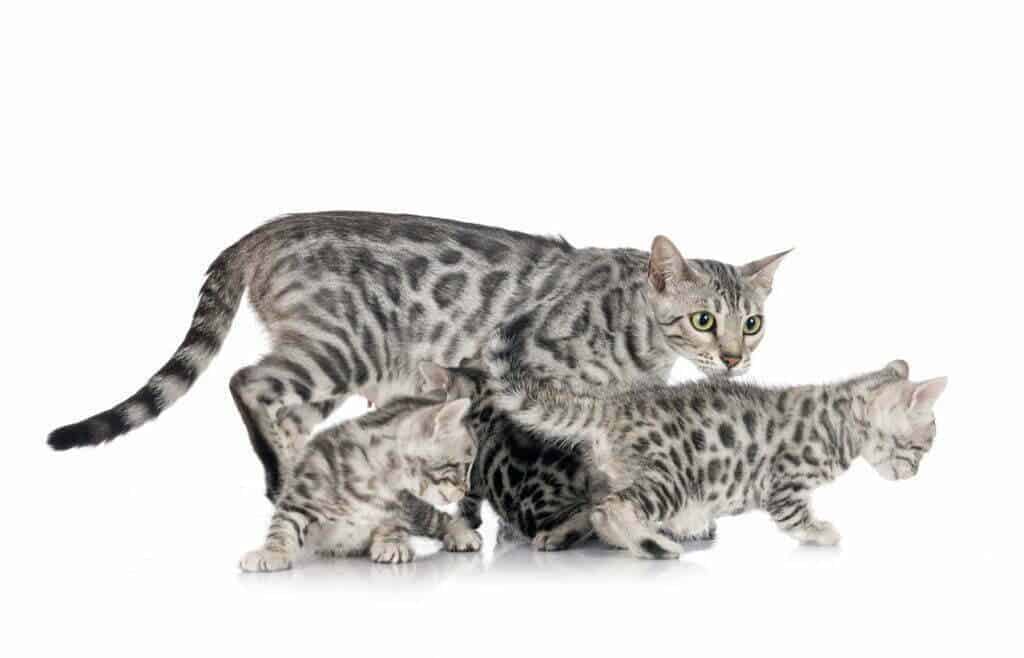A silver Bengal cat is a Bengal breed line that has been selectively bred to create silver coloring in its fur. They have a spotted or marbled coat with a frosty silver sheen that is really striking. This line of Bengal is highly sought after because of its unique coloration.
If you are curious about this beautiful feline, read on to explore the origins, coat, temperament, size, and cost of the silver Bengal cat.
Silver Bengal Cat Origins
The journey of the Bengal cat began in the 1960s and 1970s, but the Silver Bengal emerged as a specific color variation later on.
The breed itself is the result of crossing domestic cats with the Asian Leopard Cat (Prionailurus bengalensis), aiming to create a cat with the wild appearance of a leopard but the friendly nature of a household pet.
The Silver Bengal, specifically, was developed through selective breeding, intended to highlight a stunning silver coat that sets it apart from its more traditionally colored counterparts.
The origin of the silver Bengal cat is attributed to breeder Judy Sugden. Judy is the daughter of Jean Sudgen-Mill, the breeder to whom the Bengal cat hybrid is credited. Building on her mother’s work, Judy introduced a silver line in the 1990s by breeding an American Shorthair cat to a Bengal cat
The Silver Color Explained
This silver color is not a color in itself. The mesmerizing silver coat is the result of a specific gene that inhibits the warm yellow and red pigments in the fur, allowing only the black color to be expressed. This gene, known as the inhibitor gene, is what gives silver Bengals their distinctive icy, silver sheen, setting them apart from the golden or ruddy backgrounds seen in other Bengals.
With only black color remaining, the resulting coat color is a mixture of black, absence of color (white/silver), and a blend of these two (gray/silver). However, this genetic color inhibition is not always 100 percent. Sometimes small amounts of warm pigment remain, creating what breeders refer to as “tarnish” which is small amounts of yellow/red pigment throughout the coat. Tarnish may be darker on the face, legs and back.
The silver Bengal cat’s coat will have 2-3 shades of color consisting of dark gray to black markings on a silver-white background. The objective is to have as little tarnish as possible, ideally none. The tip of the tail is black. Some may confuse the silver Bengal with the snow Bengal, since they both have a very light base coat. However, the snow Bengals’ colors result from a different genetic influence where the warm pigments are not suppressed.

Coat Patterns and Eye Color
Silver Bengals boast an array of coat patterns, primarily categorized into spotted rosette and marbled.
The spotted rosette variety has distinct spots ranging from small to large, reminiscent of their leopard ancestors, while the marbled pattern showcases swirls and patches that flow across the cat’s body. These patterns are superimposed over the silver base coat, creating a stunning visual effect that highlights this beautiful cat’s exotic heritage.
Their eye color typically ranges from green to gold, unlike the snow Bengal which usually have the blue eyes of their Siamese ancestors.
Personality
Silver Bengal cats are not just beautiful; they make wonderful companions. Known for their intelligence, playful nature, and affectionate demeanor, they fit well into active households.
They are very energetic and active cats that have a strong streak of curiosity. They enjoy interaction, whether it’s playing fetch, exploring their surroundings, or simply spending time with their human companions.
These cats also tend to be quite vocal, which makes them great companions for those who enjoy talking with their pets. They enjoy interacting with humans, as well as other cats and even dogs. They are very intelligent cats that can easily learn tricks, much like a dog would. They do have a bit of a wild side, but their social and curious nature makes them excellent pets for families and individuals alike, provided their need for stimulation and interaction is met.
Size
Silver Bengal cats are medium to large-sized, with males typically weighing between 10 to 15 pounds and females slightly smaller, ranging from 7 to 12 pounds.
They are usually quite slim and muscular with long legs and a medium tail. Their athletic build reflects their energetic and playful nature, requiring ample space to explore and play.
Silver Bengal Cat Price
The price of Silver Bengal cats sold by reputable breeders averages from $1500 USD to $3000 USD.
Lower quality pet stock may be sold for as low as $600-$700 USD. Prices may also depend on whether you are buying a kitten or an adult cat.

Silver Bengal cats are less common than the traditional brown or golden-colored Bengals. Not all breeders focus on producing the silver coloration, making these cats somewhat rarer and often more sought after among enthusiasts.
This exclusivity not only makes them more appealing but also often increases their value in the pet market. Consequently, owning a Silver Bengal can be seen as a status symbol within some circles of cat lovers, as it represents both a commitment to the care of a special breed and an appreciation for its aesthetic qualities.
For many, the allure of the Silver Bengal lies not only in its beauty but also in its rarity, making it a prized addition to any home seeking a touch of exotic charm.
[Image credit: All images are used under license or with permission]
